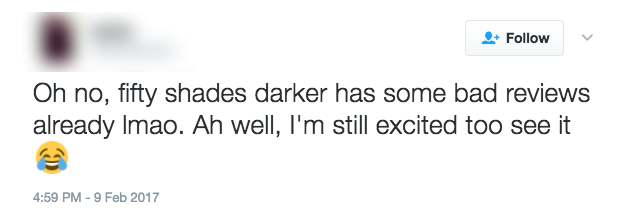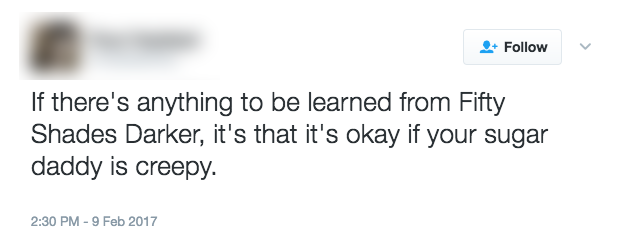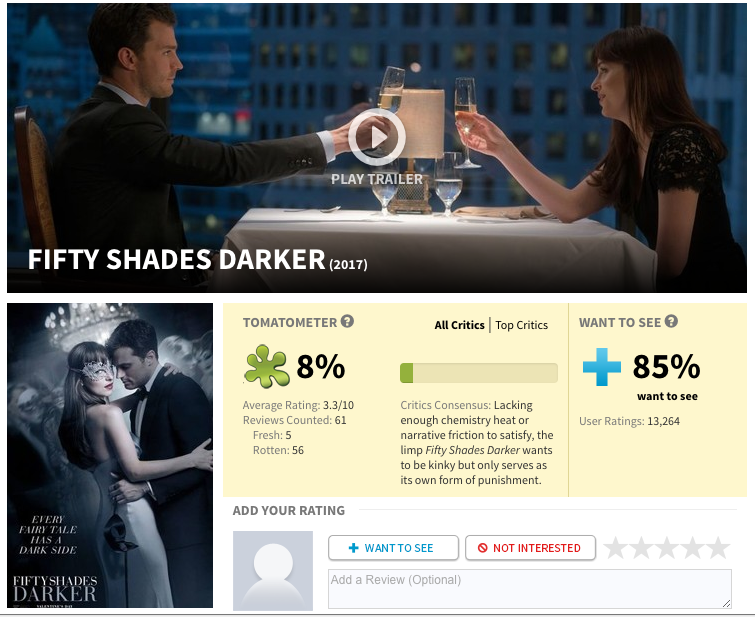Despite controversy and backlash on its harmful content, 2015’s Fifty Shades of Grey movie was a financial success, if not a critical one. Despite earning a measly 25% rating on Rotten Tomatoes and being named Worst Picture at the 36th Golden Raspberry Awards, the movie still earned $571 million at the box office. Half a billion dollars later, it now holds box office records like largest Valentine’s Day earnings and fourth-highest R-rated earnings ever.
This weekend, the next installment in the book-turned-movie franchise is set to be released. Fifty Shades Darker continues the story’s explicit storyline of sexual bondage, domination, submission, and sadomasochism between a controlling businessman and a virgin college student. Just like the release of the first film–and in ironic and gimmicky fashion–the new movie is being released the weekend before Valentine’s Day. The obvious irony is that on a day celebrated for expressing romantic love and affection, this movie is anything but.
Ever since the release of the first film, the Fifty Shades series has been the hot topic of conversation all across the nation. Let’s look at what people are saying about the most recent movie on Twitter.
Some people couldn’t care less about the negative reviews:


Others want to go see it for date night or want a lover like depicted in the movie:


And then, there are people like this:


And that seems to be the fan base of the Fifty Shades series.
Then there’s other people like us who aren’t excited at all for the release of the latest installment in this franchise due to the twisted and warped ideals about sex that these books/movies normalize in society.
Is written porn still porn?
The mission of Fight the New Drug is to use science, facts, and personal accounts to educate on the harmful effects of pornography and sexual exploitation. With that said, we know that literature can also be pornographic and we receive many messages from people who consider themselves addicted to reading “written porn.” Books like Fifty Shades contain a large amount of highly explicit and graphic sexual content and we’ve received messages from people who said that their struggle with porn began with them opening the pages of Fifty Shades of Grey.
42% of male students and 20% of women say they regularly read romance novels, sexually explicit magazines, or regularly visited sexually explicit forums or chat rooms. Erotica can be just as addictive and harmful in warping ideas about sex and intimacy as videos or images. One needs to look no further than the fact that the series is popularly referred to as “mommy porn” due to its massive popularity among middle-aged women who read it openly despite its explicit accounts of violent sex.
Negative storyline & negative reviews
In order to understand the negative effects of the books and now its big budget films, one must see the storyline for what it is. For those who aren’t familiar, the story centers around a cold and sadistic millionaire CEO who seduces an innocent, virgin college girl into hi selfish world of painful bondage sex. The explicit nature of the content in the book deals with sadomasochism (or S&M for short), also known as extreme acts of violence and abuse for sexual pleasure, complete with whips, chains, leashes, collars, and other sexual devices.
Even worse about Fifty Shades, is that this pretty much is the story. There’s not much of a plot, there’s really no big surprise ending, it is just an entire book–and now an entire movie–about a handsome businessman who seeks to dominate and act out his deviant sexual tastes with an unsuspecting virgin girl who catches his eye. Obviously this premise makes for poor storytelling, as shown by the new movie’s current rating on popular movie review site Rotten Tomatoes:

The film currently carries an unbelievably low 8% rating and the critical consensus is that the poorly made movie is so difficult to watch that it “serves as its own form of punishment.” Yet, it is interesting to note that 85% of viewers still want to see it.
The real problem with Fifty Shades
But even worse than what the story is about, is what it teaches. While Fifty Shades has gone to extraordinary lengths to market the franchise as “chic and sexy” by coming out with its own line of sex toys, lipsticks, and a popstar-studded soundtrack, all the film actually promotes is the normalization of sexual violence (mostly toward women) and deviant sexual behavior. On top of that, the story carries obvious themes of female inequality, abuse, and coercion.
In order to truly highlight the extremely negative and harmful ideals contained in the Fifty Shades franchise, we made a list, with an accompanying infographic, of what is to be learned from this story.
Read and share:
We think it goes without saying that we will be spending this Valentine’s Day weekend with our loved ones, not reading or watching disturbing sexual fetishes. We are all about real love and real intimacy, and Fifty Shades, fictional or not, is the opposite of that.

What YOU Can Do
If you’re not cool with the twisted attitudes and perceptions that movies like Fifty Shades pushes into our society, SHARE this article. Add your voice to the conversation and spread the word.
Support the movement, rep a tee. Click here to shop:
Your Support Matters Now More Than Ever
Most kids today are exposed to porn by the age of 12. By the time they’re teenagers, 75% of boys and 70% of girls have already viewed itRobb, M.B., & Mann, S. (2023). Teens and pornography. San Francisco, CA: Common Sense.Copy —often before they’ve had a single healthy conversation about it.
Even more concerning: over half of boys and nearly 40% of girls believe porn is a realistic depiction of sexMartellozzo, E., Monaghan, A., Adler, J. R., Davidson, J., Leyva, R., & Horvath, M. A. H. (2016). “I wasn’t sure it was normal to watch it”: A quantitative and qualitative examination of the impact of online pornography on the values, attitudes, beliefs and behaviours of children and young people. Middlesex University, NSPCC, & Office of the Children’s Commissioner.Copy . And among teens who have seen porn, more than 79% of teens use it to learn how to have sexRobb, M.B., & Mann, S. (2023). Teens and pornography. San Francisco, CA: Common Sense.Copy . That means millions of young people are getting sex ed from violent, degrading content, which becomes their baseline understanding of intimacy. Out of the most popular porn, 33%-88% of videos contain physical aggression and nonconsensual violence-related themesFritz, N., Malic, V., Paul, B., & Zhou, Y. (2020). A descriptive analysis of the types, targets, and relative frequency of aggression in mainstream pornography. Archives of Sexual Behavior, 49(8), 3041-3053. doi:10.1007/s10508-020-01773-0Copy Bridges et al., 2010, “Aggression and Sexual Behavior in Best-Selling Pornography Videos: A Content Analysis,” Violence Against Women.Copy .
From increasing rates of loneliness, depression, and self-doubt, to distorted views of sex, reduced relationship satisfaction, and riskier sexual behavior among teens, porn is impacting individuals, relationships, and society worldwideFight the New Drug. (2024, May). Get the Facts (Series of web articles). Fight the New Drug.Copy .
This is why Fight the New Drug exists—but we can’t do it without you.
Your donation directly fuels the creation of new educational resources, including our awareness-raising videos, podcasts, research-driven articles, engaging school presentations, and digital tools that reach youth where they are: online and in school. It equips individuals, parents, educators, and youth with trustworthy resources to start the conversation.
Will you join us? We’re grateful for whatever you can give—but a recurring donation makes the biggest difference. Every dollar directly supports our vital work, and every individual we reach decreases sexual exploitation. Let’s fight for real love:



